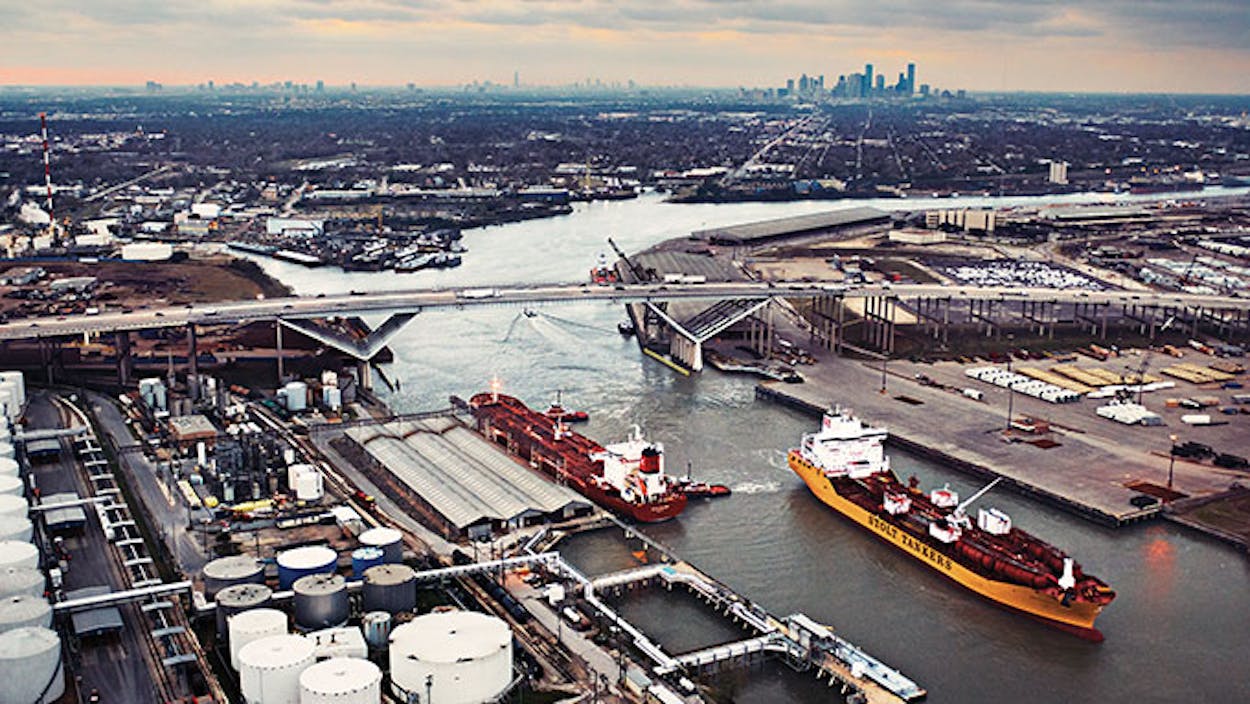It’s dawn at the site of Santa Anna’s capture, atop the Washburn Tunnel in Pasadena. Two fishermen are angling at the water’s edge, joined by a great blue heron, neck coiled and ready to strike. The greenish-brown water laps at the grassy shore, thanks to the tugboat Dixie Renegade’s wake as it nudges a chemical barge upstream, where tank farms dot the landscape. Gulls laugh and wheel in the sun-pinked clouds, only some of which are natural; the man-made variety are billowing forth from the thick jungle of smokestacks that line the Houston Ship Channel, the lifeblood of the world’s second-largest petrochemical complex.
In this Janus-faced city, it is here, on the east side, where you find Houston’s fearsomely unlovely visage. It’s one that many west-siders prefer to ignore, which is perhaps understandable, given that the area reeks like rotting cabbage. Yet the ugliness is so real that it utterly captivates, especially at night, when the countless brilliant white lights of the refineries transform it all into a giant crystal palace.
The history of the channel, which turned one hundred this year, has been told many times, in dry “commerce porn” accounts of bold captains of industry and the port’s ever-expanding gross tonnage. That’s not the approach of Pat Jasper’s exhibit, “Stories of a Workforce: Celebrating the Centennial of the Houston Ship Channel,” which is on display through January 31 at downtown’s Julia Ideson Library. By talking to scores of people who’ve made their livelihoods there, Jasper and her team have produced something more like an autobiography of the port.
“The exhibit is a document of the changes in the workforce at the Ship Channel over the last fifty years,” she says, sitting in her corner office at the Houston Arts Alliance, where she is the director of folklife and traditional arts programs. “Like almost all other American workplaces, the port and the Ship Channel have been transformed by automation and technology.”
The biggest change was the arrival of cargo containers in the late fifties. Unlike the wildly varied cargo of yesteryear, which required painstaking human intervention, those vast, uniformly sized steel boxes could be winched on and off board with cranes, which eliminated the jobs of most of the local longshoremen.
Jasper says that two other events drastically altered the Ship Channel. The 1989 Exxon Valdez disaster ushered in a new emphasis on safety. Gone in a flash were the days when workers would show up in flip-flops and a cowboy hat, carrying an iced cooler stocked with Bud. Twelve years later the post–September 11 security clampdown virtually blockaded the port to everyone but employees.
Among other things, the security measures have disrupted the channel’s bloodlines. “There was this long tradition of fathers—mostly fathers—bringing their sons down to the docks,” Jasper says. Once there, the kids would get the bug. But now they never have the chance.
Steve Bennett has worked at the port as a boatman since 1977. His job is to tie and anchor the vast steel ships once they arrive in port. “His dad was a pilot, and pilots are kind of the superheroes of this universe,” Jasper says. But the Ship Channel casts a certain spell over those who hear its siren call. “When Steve’s mom would take him to the docks, he wouldn’t see his dad working. He would see the boatmen working.” And that’s the job he wanted.








